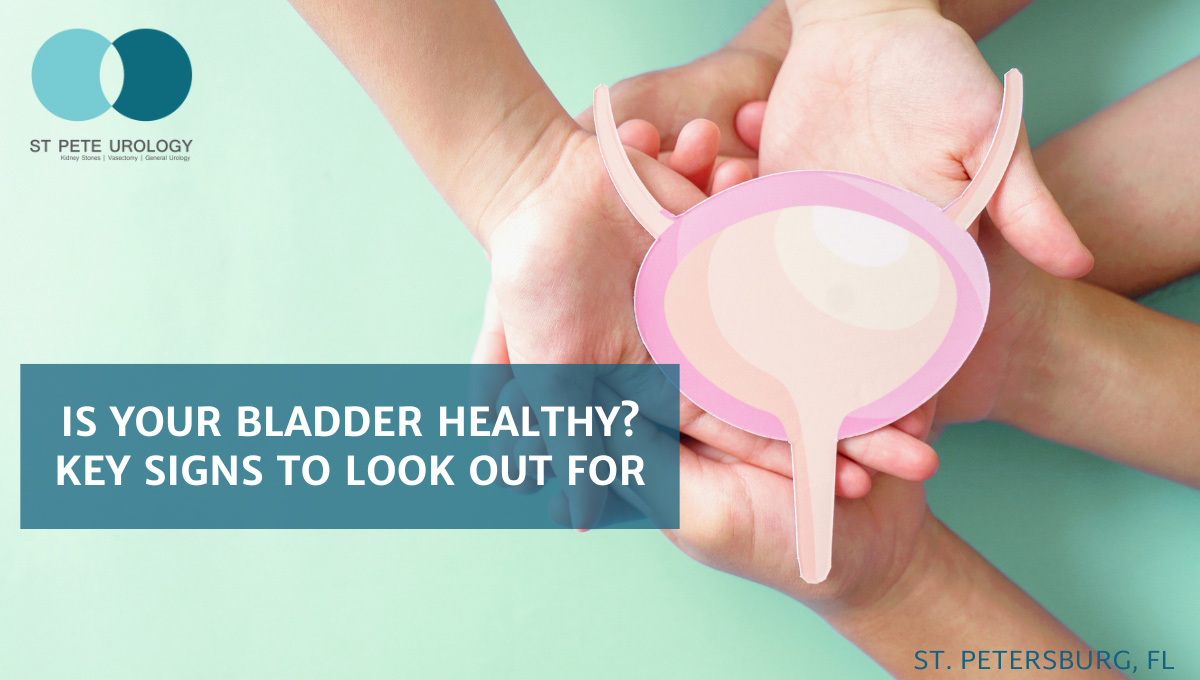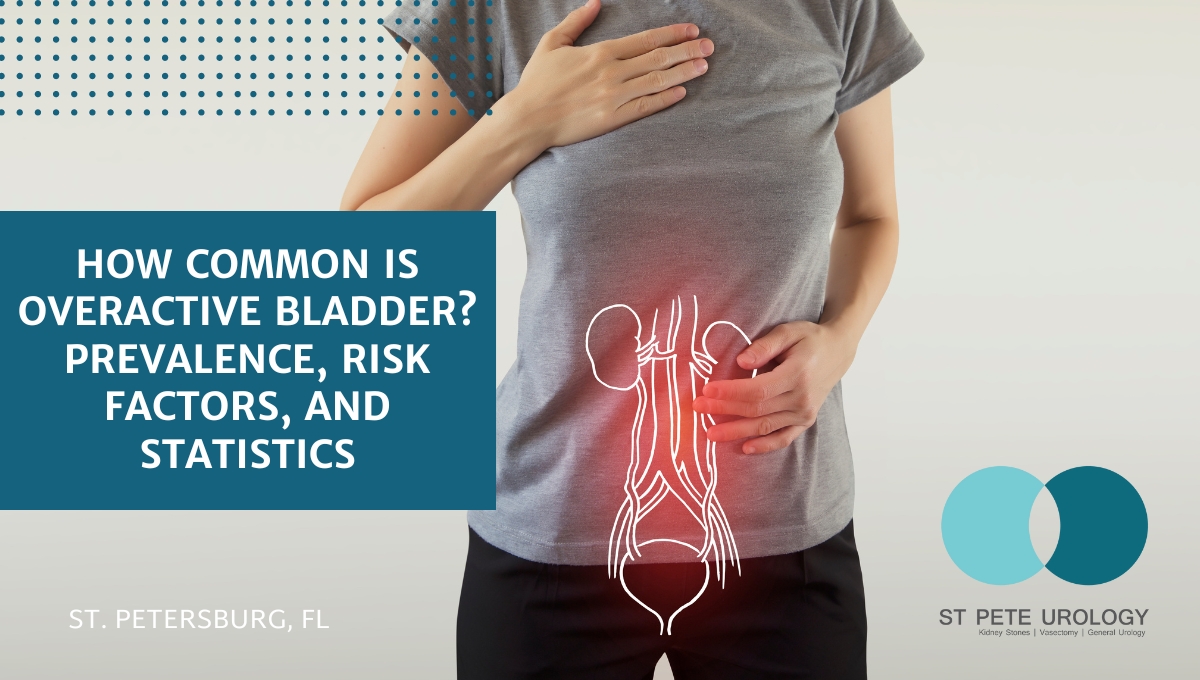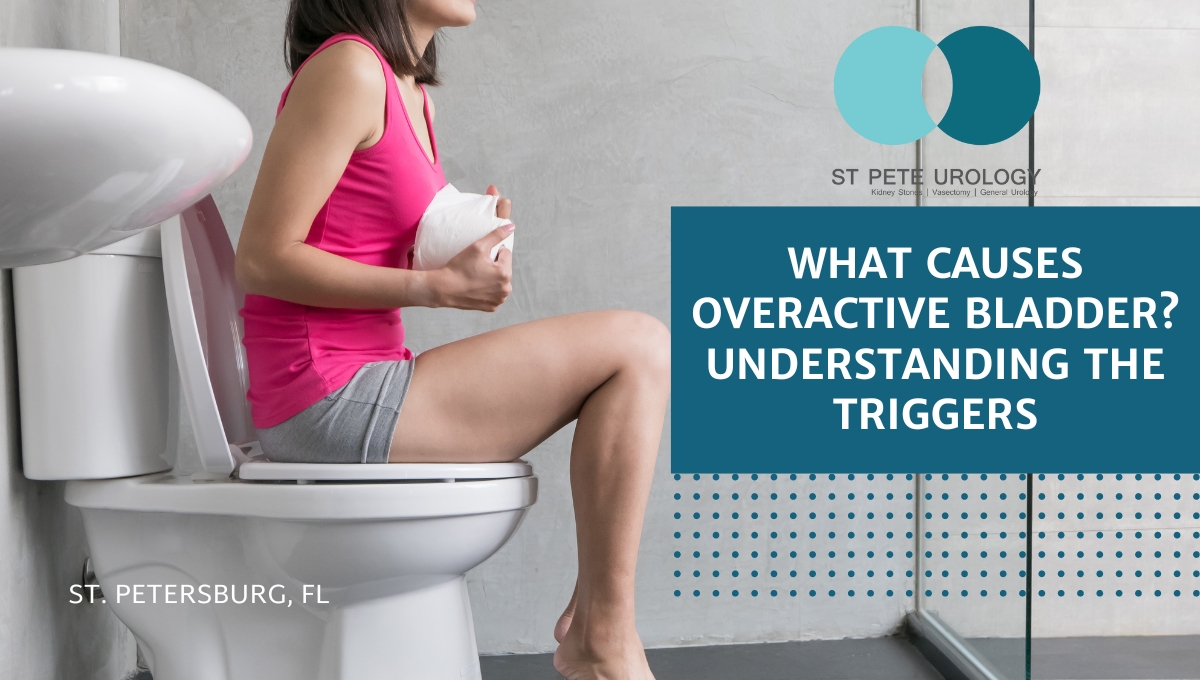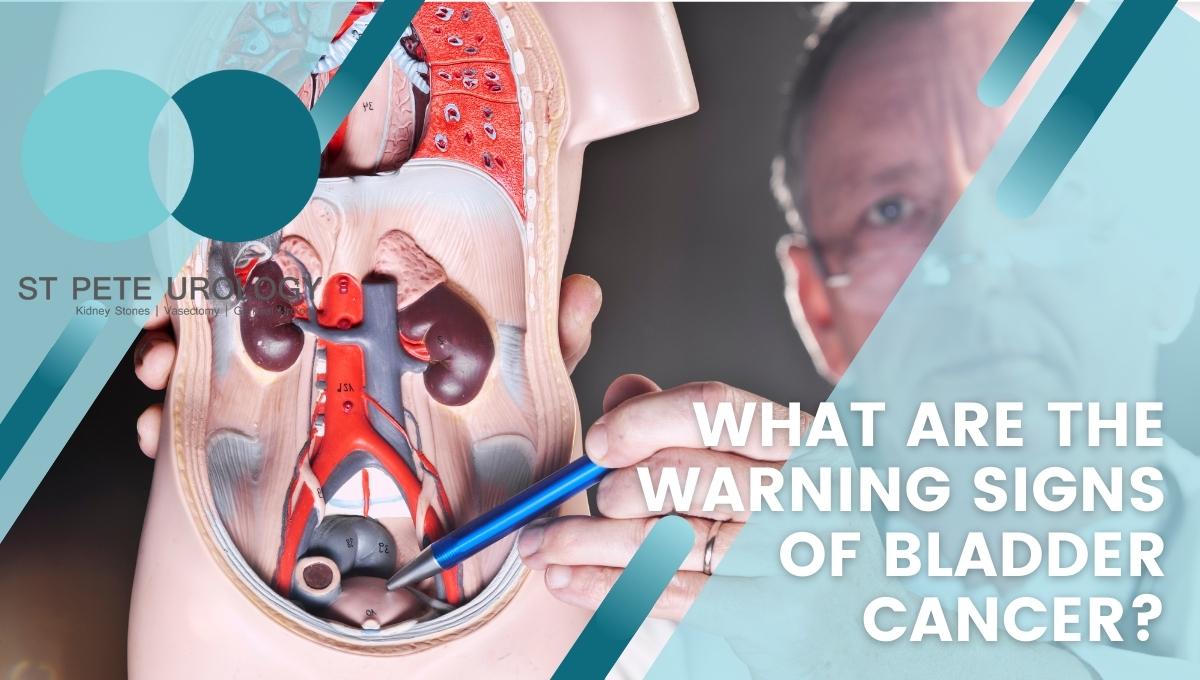Recognizing the key signs of a healthy bladder is important to monitor its condition and seek medical advice when necessary.
Continue readingWhat Are the Main Causes Behind Bladder Prolapse in Women?
Bladder prolapse, also known as cystocele, is a health condition that could impact a woman’s quality of life significantly.
Continue readingHow is Overactive Bladder Diagnosed? Tests and Exams You May Need
Key Takeaways:
1. OAB is a common bladder condition that affects over 200 million people globally, potentially impacting an individual’s quality of life.
2. Accurate diagnosis of OAB can be made through physical examination, bladder tests and imaging tests.
3. Treatment for OAB typically includes lifestyle changes, medications, and behavioral therapy. St Pete Urology is an excellent provider for diagnosis and treatment in the St. Petersburg area.
 Having a condition like an overactive bladder (OAB) can be a source of embarrassment and discomfort for an individual. Furthermore, this condition ranks among the most common bladder issues. Overactive Bladder (OAB) is characterized by a sudden and intense urge to urinate, often occurring more than 8 times a day and/or causing frequent awakenings during the night for urination (2 or more times per night). Globally, it impacts over 200 million people and can significantly disrupt one’s quality of life. In this article, we will elucidate the process of diagnosing OAB, outlining the necessary tests and examinations, available treatments, and emphasizing the importance of early diagnosis and intervention.
Having a condition like an overactive bladder (OAB) can be a source of embarrassment and discomfort for an individual. Furthermore, this condition ranks among the most common bladder issues. Overactive Bladder (OAB) is characterized by a sudden and intense urge to urinate, often occurring more than 8 times a day and/or causing frequent awakenings during the night for urination (2 or more times per night). Globally, it impacts over 200 million people and can significantly disrupt one’s quality of life. In this article, we will elucidate the process of diagnosing OAB, outlining the necessary tests and examinations, available treatments, and emphasizing the importance of early diagnosis and intervention.
Diagnosis of Overactive Bladder
The first step towards an accurate diagnosis of OAB is to make a thorough patient medical history to review prior medical history and possible underlying medical conditions that could be contributing to OAB. After an initial review, a physical examination is the next necessary step. The physical examination can provide important clues as to the possible causes of the OAB symptoms. After physical examination, bladder tests and imaging tests are the most common tests used to diagnose OAB with accurate precision.
Bladder Function Tests:
To better understand the individual’s bladder functionality, bladder function tests can be carried out. This includes urine flow tests and post-void residual (PVR) tests. Urine flow tests measure the flow rate of urine and the PVR tests measure how much urine is left in the bladder after urination. These tests give important information on the type of OAB and how it is being managed.
Imaging Tests:
Additionally, if other tests yield inconclusive results, healthcare providers may employ imaging tests to diagnose OAB. These tests have the capability to display images of the bladder and urinary tract, aiding in the identification of any underlying issues. These issues may include a blocked or narrowed urethra and abnormalities in bladder muscles or valves. Also, the presence of other underlying conditions like bladder stones or tumors.
Treatment of Overactive Bladder
Once an individual has been diagnosed with OAB, treatments to manage it can be initiated. These treatments are broken down into lifestyle changes, medications, and behavioral therapy.
Lifestyle Changes:
Making lifestyle changes is always the first step to managing OAB. Lifestyle includes reducing substance use, i.e. caffeine, alcohol or other stimulants, that can irritate the bladder. Limiting intake of fluids before bed, potential allergies to certain foods, managing stress, and increasing physical activity levels can also help to reduce pain and symptoms of OAB.
Medication:
If lifestyle changes don’t provide enough relief, medications are typically the second step in the treatment plan. Although these medications can help to reduce OAB symptoms, they can also produce unwanted side effects. Therefore, it is important to review all potential risks and side effects with your doctor before taking any medication.
Behavioral Therapy:
Behavioral therapy is another treatment type for OAB. This type of therapy is designed to help individuals gain better control of their bladders. The therapy helps to build awareness of the body’s signals when the bladders have reached a certain capacity and teaches individuals to delay or prevent urge responses.
Conclusion
Overactive bladder is a condition that affects many people and can cause significant discomfort and disruption to an individual’s daily activities. Accurate diagnosis of OAB can be made through physical examination, bladder tests and imaging tests. Once diagnosis is complete, treatment can begin. Treatments for OAB typically include lifestyle changes, medications, and behavioral therapy. Early diagnosis and treatment of OAB can help to reduce symptoms and improve quality of life.
St Pete Urology is a premier urology practice and leader in diagnosing and treating OAB in the St. Petersburg, Florida area. St Pete Urology’s dedicated team of highly experienced specialists and professional staff members work together to provide you with the best possible treatment so you can get back to living a life free from OAB symptoms and discomfort.
References:
- “Urodynamic Testing: What Is It, Procedure & What To Expect.” 17 Aug. 2020, https://my.clevelandclinic.org/health/diagnostics/15684-urodynamic-testing.
- “Overactive bladder (OAB) and lifestyle modification – Female Urology.” https://www.urineincontinence.com.au/overactive-bladder/overactive-bladder-oab-and-lifestyle-modification.
- “Diagnosing Overactive Bladder – WebMD.” 7 Jun. 2022, https://www.webmd.com/urinary-incontinence-oab/overactive-bladder-making-diagnosis.
How Common is Overactive Bladder? Prevalence, Risk Factors, and Statistics
3 Key Takeaways:
1. Overactive bladder (OAB) is a common urological condition characterized by frequent, urgent urination and disruption of day-to-day life.
2. Risk factors for developing OAB include age, gender, obesity and certain medications.
3. Early diagnosis and treatment for OAB can mitigate symptoms and improve quality of life, and St. Pete Urology can provide high-quality, individualized care for those suffering from OAB.
 Overactive bladder (OAB) is a urological condition characterized by a sudden, uncontrollable, and frequent urge to urinate. People with OAB may find themselves unable to control their urge to urinate. This can cause issues with daily routines, social activities, emotional wellbeing, and ultimately lead to a decreased quality of life. This article will explore the prevalence, risk factors, and statistics associated with OAB.
Overactive bladder (OAB) is a urological condition characterized by a sudden, uncontrollable, and frequent urge to urinate. People with OAB may find themselves unable to control their urge to urinate. This can cause issues with daily routines, social activities, emotional wellbeing, and ultimately lead to a decreased quality of life. This article will explore the prevalence, risk factors, and statistics associated with OAB.
Prevalence of OAB
According to Statistic Brain, an estimated 183 million people suffer from OAB globally. Regionally, the prevalence of OAB is highest in North America, with an estimated 66.6 million people in the U.S. are currently experiencing OAB symptoms. The global and regional prevalence of OAB is largely influenced by a range of environmental and demographic factors. These factors include the aging population, rising global health awareness, sedentary lifestyle choices, and shifts in healthcare policies.
Risk Factors for OAB
There are a number of risk factors that may increase the likelihood of developing OAB. These include age, gender, obesity, urinary tract infections, strokes and other neurological diseases, diabetes, and certain medications. Studies have shown that women are more likely to experience OAB than men, with the risk increasing with age for both genders. Additionally, there is a strong correlation between obesity and OAB, with obese individuals having a higher risk of developing OAB.
Symptoms and Impact of OAB
The primary symptoms of OAB include frequent urge to urinate, urgent urination, frequent urination, and nocturia (nighttime urination). These symptoms can cause disruption in daily life, leading to difficulties with social activities, work, and maintaining relationships. Additionally, OAB can cause emotional and mental distress, leading to anxiety, embarrassment, and depression.
Diagnosis of OAB
OAB can be effectively diagnosed with a variety of tests and procedures, including physical examinations, urine tests, urine flow tests, and bladder scans. It is important to seek early diagnosis and treatment for OAB, as this can help minimize the disruption caused by the condition.
Treatment and Management of OAB
The treatment and management of OAB will depend on the individual patient, with a range of options available, including lifestyle changes, medications, bladder training, and physical therapy. It is important to discuss treatment options with a healthcare professional, as some medications may not be suitable for all patients. Additionally, lifestyle changes and self-management strategies can help to mitigate the symptoms of OAB and improve the quality of life.
Conclusion
Overactive bladder is a common urological condition characterized by frequent, urgent urination and disruption of day-to-day life. It is important to be aware of the prevalence, risk factors, and statistics associated with OAB. Key risk factors for developing OAB include age, gender, obesity, and certain medications. It is important to seek early diagnosis and treatment for OAB, as this can help to reduce the symptoms and improve the overall quality of life.
At St. Pete Urology, we strive to provide high-quality, individualized care for those suffering from common urological conditions such as overactive bladder. With our comprehensive and comprehensive approach, you can trust us to provide you with the most effective solutions for your OAB symptoms. Contact us today to schedule an appointment and get on the path to feeling your best!
References:
- “Incontinence Types & Risk Factors – Brigham and Women’s Hospital.” https://www.brighamandwomens.org/obgyn/urogynecology/types-of-incontinence-and-risk-factors.
- “Overactive bladder – Diagnosis and treatment – Mayo Clinic.” 3 May. 2022, https://www.mayoclinic.org/diseases-conditions/overactive-bladder/diagnosis-treatment/drc-20355721.
- “Urinary Incontinence risk factors – Hospital Clínic Barcelona.” 20 Feb. 2018, https://www.clinicbarcelona.org/en/assistance/diseases/urinary-incontinence/risk-factors.
Overactive Bladder and Exercise: Can Physical Activity Help or Hurt?
Key Takeaways:
1. Exercise can help to improve overactive bladder (OAB) symptoms, such as urgency and frequency of urination, involuntary leakage, and nocturia.
2. Low-impact aerobic exercise, strength training, and pelvic floor exercises can all be beneficial for people with OAB.
3. Before beginning a new exercise routine, it is important to speak with a doctor or specialist to determine the best type of exercises for the individual.
 Exercise is essential to maintaining good physical and mental health. Regular physical activity can reduce the risk of heart disease, diabetes, stroke, and mental health problems. Exercise can also improve bowel and bladder health, but this is not always the case. Overactive bladder (OAB) is a condition that causes the bladder to suddenly fill with urine, leading to urgency and leakage, which can make physical activity challenging or uncomfortable. This article will discuss the symptoms and effects of overactive bladder and explore how exercise can help or hurt this condition.
Exercise is essential to maintaining good physical and mental health. Regular physical activity can reduce the risk of heart disease, diabetes, stroke, and mental health problems. Exercise can also improve bowel and bladder health, but this is not always the case. Overactive bladder (OAB) is a condition that causes the bladder to suddenly fill with urine, leading to urgency and leakage, which can make physical activity challenging or uncomfortable. This article will discuss the symptoms and effects of overactive bladder and explore how exercise can help or hurt this condition.
Introduction
Overactive bladder is a condition that affects both men and women, but is more common in women, especially those over the age of 40. It is defined as urinary urgency and can include the involuntary leakage of urine. Often accompanied by an urge to urinate more often than normal and nighttime urination, OAB can cause disruption to one’s daily life. Despite its prevalence, OAB often goes undiagnosed; many people don’t recognize the signs and symptoms or don’t get the appropriate treatment.
Overview of Benefits of Regular Exercise
Exercise is important for so many different reasons, both physical and emotional, and it has a myriad of health benefits. Consistent and regular physical activity can lower your risk of heart disease, stroke, mental health problems, type 2 diabetes, and some forms of cancer. Additionally, exercise can help with control of bladder pressure and manage complications from OAB. Exercises that focus on the core and hip muscles, such as abdominal crunches, squats, and Pilates, can strengthen the pelvic floor muscles, help reduce incontinence episodes, and improve bladder control.
Symptoms of Overactive Bladder
The signs and symptoms of OAB vary from person to person. Some people may experience incomplete bladder emptying, frequent urination, urgency, or nighttime awakenings due to urges and leakage. Urinary incontinence is one of the most common signs of OAB, and is defined as any involuntary leakage of urine when one is not ready or able to control or prevent it. This can occur in a variety of forms, ranging from urge incontinence (leaking with the sudden urge to urinate) to fecal incontinence (leaking of stool). Urgency is another symptom of OAB, as it is a sudden and strong urge to urinate, often without warning or a sense of control. Nocturia (excessive night-time urination) is also common in people with OAB and can disrupt one’s sleep.
Types of Exercise to Help Overactive Bladder
There are many types of exercise that can help with OAB symptoms. Low-impact aerobic exercises such as swimming, walking, and cycling are beneficial for many reasons. They are low impact so they cause less stress on the joints and muscles, but still provide a good cardiovascular workout that strengthens and tones the entire body. Strength training is also important, as it helps to build strong muscles and can improve posture, balance, and core strength. Finally, there are pelvic floor (Kegel) exercises, which are specialized exercises designed to help strengthen the muscles of the pelvic floor, which can aid in improving urinary control.
Exercise Challenges Related to Overactive Bladder
Finding the right kind of physical activity can be challenging for some people with OAB. Traditional forms of exercise such as running, jumping, and high-impact aerobic activities can exacerbate OAB symptoms or make them worse. Additionally, the fear of leakage can make it difficult for individuals to feel comfortable engaging in physical activities. Finally, OAB can cause painful symptoms that can make physical activity more difficult or even unbearable.
Conclusion
Exercise is an important part of a healthy lifestyle, and it can be beneficial for people with overactive bladder. Low-impact aerobic exercise, strength training, and pelvic floor exercises can all help improve OAB symptoms such as urinary incontinence, urgency and frequency, and nocturia. However, finding the right kind of exercise can be challenging, and dealing with the fear of leakage or painful symptoms can make exercise even more difficult. It is important to find an exercise routine that works best for the individual.
Summary of Benefits of Exercise for Overactive Bladder
Regular physical activity can provide many health benefits, and it can be a great way to manage the symptoms of overactive bladder. Low-impact aerobic exercises, strength training, and pelvic floor exercises can all be beneficial for people with OAB. However, finding the right exercise routine may be challenging and dealing with the fears and painful symptoms can be difficult. It is important to speak with a doctor or specialist to determine the best type of exercise for each individual’s situation.
Closing Thoughts
Exercise can be a great way to manage and improve the symptoms of overactive bladder. However, it is important to speak with a doctor and/or specialist before beginning a new exercise program to ensure it is appropriate for your condition. If you live in the St. Petersburg area and are looking for help managing OAB symptoms through specialized exercises, St Pete Urology specializes in helping people with OAB find the right kind of exercise routine to improve their health.
References:
- “Focus on Fitness: Exercising With Bladder Problems – Today’s Dietitian.” https://www.todaysdietitian.com/newarchives/1118p56.shtml.
- “Urinary Incontinence: 4 Exercises For An Overactive Bladder.” 10 Sep. 2021, https://mytexashealthcareobgyn.com/well-woman-care/urinary-incontinence-4-exercises-for-an-overactive-bladder/.
- “What Is Overactive Bladder (OAB)?.” https://nafc.org/overactive-bladder/.
What Should You Eat with Overactive Bladder? Diet Tips and Foods to Avoid
3 Key Takeaways:
1. Eating foods high in fibre such as leafy greens, legumes, and whole grains can help improve OAB symptoms.
2. Staying hydrated by drinking enough water regularly can also help reduce OAB symptoms.
3. Exercising regularly can help strengthen the muscles in the bladder and improve OAB symptoms.
 Overactive bladder is a condition that affects many people, and the effects can be very uncomfortable. It is important to understand potential dietary causes for your OAB and learn about foods that you can eat to help improve your bladder health. In this article, we will discuss what an overactive bladder is, potential causes, diet tips, and foods to avoid to improve your bladder health.
Overactive bladder is a condition that affects many people, and the effects can be very uncomfortable. It is important to understand potential dietary causes for your OAB and learn about foods that you can eat to help improve your bladder health. In this article, we will discuss what an overactive bladder is, potential causes, diet tips, and foods to avoid to improve your bladder health.
What is an Overactive Bladder?
An overactive bladder (OAB) is a condition that affects the bladder by causing sudden, uncontrollable urges to urinate, even when your bladder is not full. These sudden urges can make everyday life uncomfortable and difficult, leading to embarrassment, and lack of time to get to a bathroom quickly. Common symptoms of overactive bladder include an urgent and frequent need to urinate, a feeling of not being able to hold onto the urine, and an increased need to “go” at night.
Potential Causes of Overactive Bladder
Your diet is one of the most influential factors in your bladder health. Certain nutrients in foods can have an influence on your urinary tract and bladder, including some minerals and vitamins. Additionally, certain foods may promote overactive bladder, including foods and drinks that are high in caffeine and artificial sweeteners. Furthermore, unhealthy eating habits, such as skipping meals and eating later in the day, may also play a role in the development of bladder issues.
To help improve OAB, it’s important to look at the foods and beverages you’re consuming and make changes to your diet. Here are some diet tips that may help improve your OAB.
Foods That Can Help Improve Overactive Bladder
To improve your overactive bladder, it’s important to focus on adding certain healthy goodies into your diet. Eating certain herbs and spices, such as turmeric and ginger, may help reduce inflammation in the bladder and provide relief of OAB symptoms. Fruits and vegetables, such as apples, bananas, and carrots, may also provide relief of symptoms. Additionally, including some whole grains in your diet, such as brown rice and oatmeal, may help improve OAB symptoms.
Changes in Diet and Lifestyle That Can Help Reduce Symptoms of Overactive Bladder
In addition to including more fruits and vegetables in your diet, adding fibre can also help improve OAB. Fibre soaks up water, which can help with controlling bladder urges. Eating foods high in fibre like leafy greens, legumes and whole grains can help with improving the OAB symptoms.
Drinking water is also key for controlling OAB symptoms. Staying hydrated throughout the day helps keep your body running, and in turn, helps regulate your bladder. Drinking enough water regularly can help reduce OAB symptoms.
Finally, getting regular exercise is important for improving OAB. Exercise helps strengthen the muscles in the bladder, which in turn may help to stop unwanted bladder urges. Getting regular physical activity can help improve OAB symptoms.
Conclusion:
In conclusion, diet and lifestyle modifications can be effective tools for improving overactive bladder. Eating a balanced diet full of fruits and vegetables, whole grains, and adding fibre to help with water absorption, can help reduce OAB symptoms. Also, drinking enough water to stay hydrated is key for controlling OAB, and getting regular exercise can help strengthen the muscles in the bladder.
At St Pete Urology, we understand how difficult and embarrassing an overactive bladder can be. Our team of experts can help provide advice and options for improving and managing your bladder issues. Contact us today to learn more about how we can help.
References:
- “Frequent Urination in Men and Women: Causes & Treatments.” 15 May. 2021, https://www.webmd.com/urinary-incontinence-oab/frequent-urination-causes-and-treatments.
- “Bladder control: Lifestyle strategies ease problems – Mayo Clinic.” https://www.mayoclinic.org/diseases-conditions/urinary-incontinence/in-depth/bladder-control-problem/art-20046597.
- “Overactive Bladder (OAB): Causes, Symptoms & Treatment.” 13 Sep. 2022, https://my.clevelandclinic.org/health/diseases/14248-overactive-bladder.
What Causes Overactive Bladder? Understanding the Triggers
Key Takeaways:
- Overactive Bladder (OAB) is a common condition that can be caused by various physiological, psychological, lifestyle, and age-related factors.
- There are a variety of treatment options available for OAB, including medication, behavioral therapy, and bladder retraining.
- Individuals experiencing OAB should visit a urologist to receive proper diagnosis and treatment.
What Causes Overactive Bladder? Understanding the Triggers
 For anyone suffering from the frequent, sudden, and uncontrollable need to urinate, what causes overactive bladder is of utmost importance. This condition, known as OAB, afflicts a large number of Americans, with some estimates as high as fifty million. Fortunately, with the right treatment, OAB can be effectively managed and even eliminated. To do this, however, one must first identify and understand the cause of their overactive bladder. This article will provide an overview of the various causes of OAB, as well as treatment options available.
For anyone suffering from the frequent, sudden, and uncontrollable need to urinate, what causes overactive bladder is of utmost importance. This condition, known as OAB, afflicts a large number of Americans, with some estimates as high as fifty million. Fortunately, with the right treatment, OAB can be effectively managed and even eliminated. To do this, however, one must first identify and understand the cause of their overactive bladder. This article will provide an overview of the various causes of OAB, as well as treatment options available.
Introduction
OAB is defined as “a condition in which the urge to urinate occurs often and uncontrollably.” (Mayo Clinic Staff, 2020). Those suffering from OAB can experience frequent urges throughout the day, sometimes even resulting in accidental leakage. OAB affects people of all ages, genders, and backgrounds, and is an increasingly common medical concern. While there is no universal cause for OAB, certain physiological, psychological, lifestyle, and age-related factors can all increase one’s odds of developing the condition.
Physiological Causes
Injury to the Bladder.
Due to its location in the body and the nature of the activity in which it is involved, the bladder is vulnerable to injury and trauma. Bladder stones, infection, and other conditions can all damage the bladder, resulting in permanent or temporary overactive bladder. In some cases, damage to the pelvic floor muscles, the muscles that support and stabilize the bladder and other pelvic organs, can also contribute to OAB.
Diabetes.
Diabetes can cause nerve damage over time, often leading to potential bladder dysfunction. Through the loss of nerve function, the bladder can become overactive and cause sudden, frequent urges to urinate. In some cases, those who experience nerve damage from diabetes may become incontinent if their OAB is untreated.
Psychological Causes
Stress.
The connection between the mind and body is well-documented and stress can lead to a number of physical symptoms, including OAB. Stress-related OAB is often caused when the body is in a state of fight-or-flight, causing bladder muscles to contract and stiffen. This can cause frequent and urgent urination.
Anxiety.
Much like stress, anxiety can also be an underlying factor of OAB. Persistent anxiety often cause the body to be in an involuntary state of alertness, resulting in involuntary contractions of the bladder. These contractions can lead to OAB over time.
Depression.
Depression is a common mental health disorder and can also be linked to OAB. One possible factor is the decreased production of neurotransmitters in the brain, which can result in a weakened control over the bladder. This can lead to increased frequency of urination and other symptoms of an overactive bladder.
Lifestyle Factors
Alcohol Consumption.
Alcohol consumption can be a contributing factor to OAB. It has a diuretic effect, meaning it can cause the body to rapidly produce more urine. For people with a sensitive bladder, this can lead to OAB. It is important to note, however, that alcohol consumption is only a factor in those who are either alcoholics or have alcohol abuse issues.
Caffeine Intake.
Caffeine is known to act as a stimulant and can increase urine production. Large quantities of caffeine can lead to increased pressure on the bladder and contribute to OAB. For those who are particularly sensitive to caffeine, consuming it in any amount can lead to OAB.
Smoking.
The nicotine and other chemicals in cigarettes can irritate the bladder, leading to involuntary contractions and involuntary urination. Smokers are more at risk of developing OAB over time and those who cease smoking often find that their symptoms improve.
Age-Related Causes
Increasing Age.
As people grow older, certain age-related changes can take place in their bodies. For example, aging can decrease the capacity of the bladder, resulting in more frequent trips to the bathroom than in younger individuals. Additionally, physical and neurological changes can lead to weakened bladder muscles and nerve damage, contributing to OAB.
Menopause.
Some women experience an increase in urinary incontinence as they enter menopause. This is due in part to fluctuating levels of estrogen, which can cause the bladder wall to be weakened. Additionally, symptoms of menopause, including night sweats, can increase the amount of fluids in the body, making it more difficult to control bladder functions.
Treatment Options
Medication.
Medication is the most common form of treatment for OAB. Common medications for OAB include anticholinergics, botulinum toxin type A, and beta-3 agonists. These medications work to reduce the urgency and frequency of urination, as well as relax affected bladder muscles.
Behavioral therapy.
Certain bladder-specific exercises can help to strengthen the bladder and improve its functioning. Behavioral therapy is sometimes used in cases of OAB in order to instill new, helpful behaviors in the patient. Some examples of behavioral therapies for OAB include bladder retraining, pelvic muscle exercises, and electrical stimulation.
Bladder retraining.
Bladder retraining is a type of behavioral therapy that focuses on helping a person gain better control of their bladder. This involves gradually increasing the time between bathroom trips, as well as practicing other healthy bladder behaviors and techniques. Over time, this can help to improve OAB symptoms.
Conclusion
In summary, overactive bladder is a common condition that is caused by a variety of different factors. Physiological causes of OAB include injury to the bladder, weakened pelvic floor muscles, and diabetes. Psychological causes of OAB include stress, anxiety, and depression. Lifestyle factors, such as alcohol consumption, caffeine intake, and smoking, can all increase one’s risk of developing OAB. Additionally, age-related causes, such as increasing age and menopause, can contribute to OAB as well. Fortunately, there are a variety of treatment options available, including medication, behavioral therapy, and bladder retraining.
If you are struggling with OAB, it is important to visit a urologist for proper diagnosis and treatment. At St Pete Urology, our team of expert urologists can diagnose and treat OAB, as well as provide a variety of other urology services. Visit our website to learn more about our team and how we can help you.
References:
- “The 5 Best Exercises to Prevent & Treat Female Overactive Bladder.” 14 Feb. 2023, https://www.urologyspecialistsnc.com/female-oab-exercises/.
- “Overactive bladder – Symptoms and causes – Mayo Clinic.” 3 May. 2022, https://www.mayoclinic.org/diseases-conditions/overactive-bladder/symptoms-causes/syc-20355715.
- “Overactive Bladder (OAB): Symptoms, Diagnosis & Treatment.” https://www.urologyhealth.org/urology-a-z/o/overactive-bladder-(oab).
How Our Urinary Systems Age With Us
 Your urinary system often reflects your overall health.
Your urinary system often reflects your overall health.
A healthy urinary system works to filter blood and to remove toxins and wastes produced in the body through urine. It also helps to maintain the balance of water, minerals and salts in your blood. Plus, it enables your body to make red cells and regulate blood pressure.
By removing wastes and toxins and regulating fluids and electrolytes, the urinary system helps the body regulate itself and work properly. That is why it’s essential to protect your urinary health as a way of improving your overall health as you age.
In fact, if you take common sense steps early in life to protect your urinary health it will significantly contribute to good overall health later in life especially after the age of 40 years.
So how does your urinary system age with you?
- Kidneys
The number of cells in your kidneys decrease once you’re 40 years or older. This results in thickening of the connective tissue capsule surrounding the kidney and a reduction in the thickness of the cortical region.
The loss of cells causes loss in glomeruli function. And because the glomeruli are responsible for filtration, loss of function of the glomeruli leads to a natural yet gradual decline of kidney function.
Between the ages of 30 and 40 years, the rate of filtration in your kidneys begins to slowly decline, the size of the kidneys begins to reduce and the arteries supplying blood to the kidneys begin to narrow. In turn, your kidneys become more susceptible to injury and kidney disease.
- Bladder
The walls of your bladder and urethra are made of smooth muscles. As you grow older, the muscle tissue weakens and becomes less elastic. In turn, the capacity of your bladder reduces, resulting in difficulty to fully evacuate during urination.
Likewise, the bladder wall generally becomes stiffer as you grow older. This reduces the bladder’s ability to hold as much urine as your younger self. And as your ability to hold urine reduces, you end up urinating more often with a higher risk of urinary tract infections.
Accidental urine leakage results from muscle weakness in the bladder and is more frequent in older people, especially women. More than 50-percent of people aged 65 and older have urinary incontinence symptoms.
By the time you are 80 years or older, bladder control may be sufficiently diminished that many find themselves waking to pass urine during the night.
Various age-related causes of urinary incontinence include:
- Weak pelvic floor muscles
- Nerve damage
- Urinary tract infections
- An enlarged prostate (in men)
The most common treatment options for urinary incontinence are surgery and targeted nerve stimulation.
Another age-related urinary system condition is bladder cancer. Though the disease is not very common, the chance of having it increases with age. In fact, over 70-percent of cases of the cancer are diagnosed in people who are 65 years or older.
Risk factors include exposure to carcinogens, tobacco smoking, and radiation. The most common symptoms are blood in urine (hematuria) and pain during urination. It is advisable to speak with a urologist if you experience these symptoms.
- Urethra
After the age of 40 years, your risk of having urinary tract infections increases due to changes in the urethra. The infections may occur when bacteria invade the urethra, multiply and spread to the upper parts of the urinary system such as bladder and kidneys.
While urinary tract infections are more commonly a concern in aging women, it can also be a problem for men. More than 50-percent of women have urinary tract infections at least once in their lifetime as opposed to just 3-percent of men.
Advancing age is also a factor in UTIs as a result of general immunity weakening with age. Plus, the infections may be more frequent in older people due to urinary incontinence and retention. When not treated promptly, infections that begin in the urethra can in some cases lead to kidney infections and even sepsis.
- Prostate
The prostate is not a urinary organ; it is part of the male reproductive system. However, changes in the prostate result in problems in the urinary system. This is largely due to the prostate gland gradually enlarging after the age of 40 years and leading to extra pressure applied to the bladder, blocking urine flow.
More than 30-percent of men aged 50 years or older require treatment for an enlarged prostate (BPH) while up to 90-percent of men aged 80 years have an enlarged prostate. An enlarged prostate is not cancer, but it is associated with bothersome health issues, such as urinary tract infections, kidney infections, urinary incontinence and bladder damage.
The most common symptoms of BPH are change in urination, inability to start to pee, and a weak urine stream. Speak with your urologist about BPH symptoms as soon as they start in order to get prompt, effective treatment.
Timely urological care
To prevent age-related urinary issues, consider making regular visits to your urologist. The doctor is a specialist with the skills and experience to assess your specific symptoms, ask the right questions, make the appropriate diagnosis and find the right treatment options.
Speak with your urologist as soon as possible to get the right medications or minimally invasive treatment for relief of the symptoms. For more information on the prevention, diagnosis and treatment of urological disorders, visit the site “St Pete Urology.”
Common Bladder Control Problems
Tonight we’re going to talk about bowel and bladder control primarily. So Dr. Graves and I both actually trained together at the University of Pennsylvania in Philadelphia and we’ve been each practicing for close to 10 years. And we’ve had five years of urology training in residency and med school before that.
And the topic tonight is something that we do have a lot of focus in and enjoy taking care of and have specialty in. All right so there’s three kind of categories to kind of simplify this about bladder control issues. One is stress incontinence and I’ll describe that more in the next slides. The second is urinary retention which is the inability to actually get urine out where the urine is trapped in the bladder and you can’t fully empty the bladder and the third is overactive bladder.
So stress incontinence is the kind of incontinence that some patients can have in which when you increase the pressure on the bladder it overcomes the ability of the sphincter to control the urine. So sneezing, coughing, laughing, standing up real quick after you’ve been sitting for a while, climbing up things like stairs, exercising and then you get a dribble or even sometimes a full emptying of the bladder as you do those activities so that’s deemed stress incontinence. And that is an issue typically with the sphincter itself and the pelvic floor with the inability to control the bladder from emptying. And that’s an issue that some women have with age or after childbirth that can occur. In regards to men that would be something that sometimes we see after prostate type procedures and then also you know something with the age that can occur. In regards to urinary retention that’s when you can’t fully empty your bladder. Sometimes patients will show up with to the emergency room or our office with the inability to empty their bladder and they need a catheter put in to drain the bladder. Other times it could be a slow chronic situation where they don’t empty the bladder fully and it builds up into a inability to empty. That’s actually dangerous because you’re not able to clear all the toxins out of your body and you can get infections or kidney failure, this is something that’s important to tease out. Usually in these cases you can have leaking but the main symptom is difficulty emptying and a weak stream. And then overactive bladder is is a quite common situation in which you have a bladder that isn’t able to hold urine for the amount of time it should in between urination. So you get frequent trips to the bathroom with strong urges to pee even though you just urinated, went to the bathroom and peed you know 20 minutes 30 minutes later you feel like you got to go again and are heading back to the bathroom. And that can sometimes progress into urge incontinence which is a type of leaking of urine as opposed to the stress incontinence where you sneeze cough strain and leak this is where you get a strong urge to pee and you can’t hold it back and then you end up having a leak before you make it to the bathroom in time.
And then a different kind of incontinence would be this fecal incontinence which is basically bowel incontinence and this is not urinary incontinence but a situation in which you have control issues with having bowel movements. So you can actually have loss of control where you have accidents with your stool sometimes that could be this like a strong urge that you cannot control or other times it’s a loss of feeling that you have to go and you can have either small accidents or a full incontinent episode with fecal incontinence
What are the warning signs of bladder cancer?
 Because the bladder holds urine produced by the kidneys, the warning signs of bladder cancer usually relate to urination. Urine is made in the kidneys and moves down the ureters to the bladder, which then stores the urine to allow for an infrequent, controlled urination.
Because the bladder holds urine produced by the kidneys, the warning signs of bladder cancer usually relate to urination. Urine is made in the kidneys and moves down the ureters to the bladder, which then stores the urine to allow for an infrequent, controlled urination.
Blood in urine
The earliest warning sign of bladder cancer is blood in urine, also called hematuria. The blood may be present in the urine regularly or appear sporadically over the course of days or weeks. Plus, it may change the color of urine to orange, pink or dark red—though sometimes there may be no apparent urine color change.
Blood in urine is a critical sign of the cancer because early-stage bladder cancer does not often cause pain or other symptoms except bleeding. In fact, bladder cancer is usually diagnosed after patients tell their doctor about having urine in their blood.
Gross hematuria is when blood is present in urine in such a large quantity that the patient can see it. But sometimes, there may be microscopic hematuria, whereby the blood is present is such a small amount that it can’t be seen by the naked eye, though can be detected by a urine test.
Nevertheless, blood in urine is not always an indicator of bladder tumor. It could be due to other less serious conditions, such as urinary tract infections, bladder stones, kidney stones, kidney disease, or non-cancerous tumors. Plus, in women, blood from menstruation may appear in urine and could cause a false-positive test result.
Urinary symptoms
While changes in urination are often a sign of less serious conditions, such as urinary tract infections, overactive bladder, benign tumor, bladder stones, or in men, an enlarged prostate, they may also be an early warning sign of bladder cancer.
Urinary symptoms that may indicate bladder cancer include:
- Pain or burning sensation during urination
- Frequent urination
- Nocturia—having to urinate many times throughout the night
- Feeling the urge to urinate even when the bladder is not full
- Having the urge to urinate, but being unable to pass urine
- Weak urine stream
- Lower back pain, often on one side of the body
When experiencing these changes, it is advisable to speak with your doctor as soon as possible. Your doctor will do a medical exam and order specific tests to help identify the cause of the symptoms. The doctor will also be able to rule out the cancer or run further tests to diagnose the cancer so that you are put on early treatment.
Advanced bladder cancer warning signs
Not everyone with early-stage bladder cancer will have symptoms. In some people, the first warning signs appear when the cancer has already grown too big or has spread beyond the bladder.
Warning signs of advanced bladder cancer include:
- Pelvic pain
- Lower back pain, usually on one side
- Fatigue or general body weakness
- Inability to urinate
- Swelling of the feet
- Bone pain
- Unexplained weight loss
- Loss of appetite
For bladder cancer that has spread to other parts of the body, the symptoms typically depend on the affected organ. For instance, if the cancer has spread to the lungs, it may produce shortness of breath or persistent coughing.
Equally, if the cancer has spread to the liver, it may cause jaundice (yellowing of the skin or eyes) and abdominal pain. And if the cancer has spread to bones, it may lead to bone pain or a broken bone (fracture).
Timely diagnosis and treatment
If you are having blood in urine, urinary symptoms or other disturbing changes, speak with your doctor about them. The doctor will seek to establish how long, how severe, and how often you have been experiencing the symptoms.
Together with performing a physical examination and ordering lab tests, the doctor will try to figure out the problem. If bladder cancer is suspected, your doctor will request for further tests to confirm the diagnosis.
For more information on bladder cancer, its signs and symptoms, risks and prevention, and diagnosis and treatment, visit the site “St Pete Urology.”










